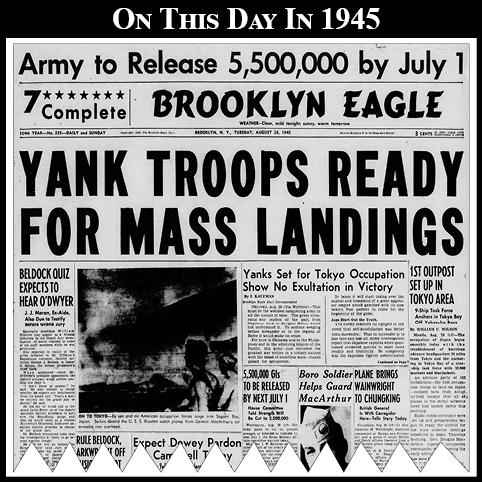August 28: ON THIS DAY in 1945, Yank troops ready for mass landings

ON THIS DAY IN 1876, the Brooklyn Daily Eagle reported, “Mr. John McNevin, the well-known artist of this city, has just finished a picture of grand size, representing the Pennsylvania and Maryland Militia, led by General [John] Sullivan, in the Battle of Long Island, August 27, 1776, surrounded by the Hessians and Forty-second British Highlanders, in their desperate attempt to force a passage to the American lines at Fort Greene, near Freck’s Pond, Gowanus Creek. Mr. McNevin has lived in Brooklyn more than twenty years, and has made the topography of the battlefield a subject of earnest thought and study. The readers of Revolutionary history will remember that General Sullivan and his command were stationed at what was known as the Flatbush Pass, and that when his position was cannonaded by [Gen. Leopold] de Heister and the Hessians, he perceived his peril and ordered a retreat to the American lines at Brooklyn.”
***
ON THIS DAY IN 1918, the Eagle reported, “Nogales, Ariz. — Profound regrets for yesterday’s clash between Mexican and American soldiers were expressed by General Elias Calles, military governor of Sonora, to Brigadier General De Rosey Cabell, in a telegram received from General Calles at Magdalena, Sonora, today. General Calles stated he had been ordered to proceed to the border by President [Venustiano] Carranza to express these regrets personally … According to latest reports, two Americans — one officer and one enlisted man — were killed, and twenty-nine Americans, ten of them enlisted men, were wounded. Unofficial estimates placed the number of Mexican dead and wounded at 150, but the Mexican Consul asserted this figure was probably an exaggeration. Among the Americans wounded is Lieutenant Colonel Frederick Herman, commander of the border patrol here. His wound is not serious. The fighting began at 4:15 yesterday afternoon, when a Mexican attempted to cross into the United States. A.A. Barber, a United States customs guard, twice ordered the Mexican to halt, and when the latter failed to comply, Barber drew his pistol but did not fire. Two Mexican customs guards, according to Barber’s account, resented his interference with the Mexican and opened fire.”

Brooklyn Boro
View MoreNew York City’s most populous borough, Brooklyn, is home to nearly 2.6 million residents. If Brooklyn were an independent city it would be the fourth largest city in the United States. While Brooklyn has become the epitome of ‘cool and hip’ in recent years, for those that were born here, raised families here and improved communities over the years, Brooklyn has never been ‘uncool’.